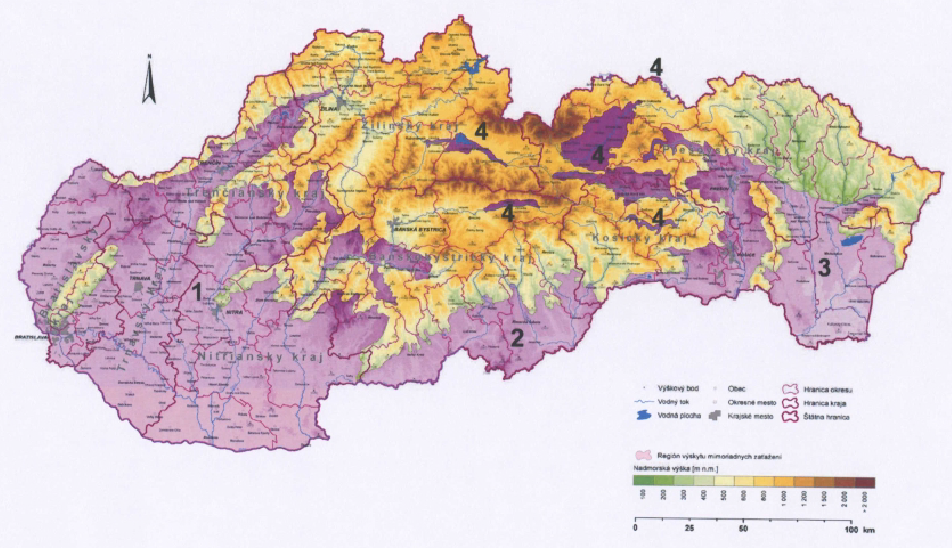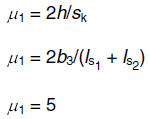Documentation
This document contains all National annex values, which are used in SDF - Basic package
Clause 4.1 Characteristic values, paragraph (1)
The characteristic values of snow load on the ground sk are calculated by formula.
sk = a + A/b
where:
A is the altitude above sea level
a, b are coefficients from the table according to the snow zone from the map.
| a |
0,454 |
0,425 |
0,716 |
0,934 |
| b |
970 |
505 |
430 |
315 |

Clause 4.3 Treatment of exceptional snow loads on the ground, paragraph (1)
Exceptional snow load coefficient is selected from the table according to the Exceptional snow load map

Clause 5.2 Load arrangements, paragraph (7)
Recommended values are used
Clause 5.2 Load arrangements, paragraph (8)
Recommended values are used
Clause 5.3.3 Pitched roofs, paragraph (4)
Standard drifted load arrangement is used.
Clause 5.3.4 Multi-span roofs, paragraph (3)
Annex B should be used instad of standard load arrangement.
Annex B:

Shape coefficient μ1 is determined as the least value of:

Drift lengths are determined as:

Clause 5.3.4 Multi-span roofs, paragraph (4)
Recommended values are used
Clause 5.3.5 Cylindrical roofs, paragraph (1)
Recommended values are used
Clause 5.3.5 Cylindrical roofs, paragraph (3)
Standard drifted snow load is used.
Clause 5.3.6 Roof abutting and close to taller construction works, paragraph (1)
Recommended range for values is used
Clause 5.3.6 Roof abutting and close to taller construction works, paragraph (3)
Annex B should be used to determine the drifted snow load case.
Annex B can be used also for construction close to taller building, if constructions are less than 1,5 m away.
Annex B:

Drift length ls is the least value of 5h, b1 or 15 m.
Table 3: Shape coefficients for exceptional snow drift for roofs abutting and close to taller structures
| μ1 |
μ3 |
μ3{[30 - α]/15} |
0 |
0 |
| μ2 |
μ3 |
μ3 |
μ3{[60 - α]/30} |
0 |
μ3 is the least value of 2h/sk, 2b/ls or 8.
b is larger of b1 or b2.
ls it she least value of 5h, b1 or 15 m.
Clause 6.2 Drifting at projections and obstructions, paragraph (2)
Annex B should be used to determine the drifted snow load case.
Annex B:
If the vertical elevation against which a drift could form is not greater than 1 m2, the effect of drifting can be ignored.
This clause applies to:
- Drifting against obstructions not exceeding 1 m in height.
- Drifting on canopies, projecting not more than 5m from the face of the building over doors and loading bays, irrespective of the height of the obstruction.
- Slender obstructions over 1 m high but not more than 2 m wide, may be considered as local projections. For this specific case h may be taken as the lesser of the projection height or width perpendicular to the direction of the wind.

The shape coefficient is determined as the least value of:
μ1 = 2h1/sk or 5
μ2 = 2h2/sk or 5
In addition, for door canopies projecting not more than 5 m from the building, μ1 should not exceed 2b/ls1, where b is the larger of b1 and b2.
The drift length (lsi) is taken as the least value of 5h or bi, where i = 1 or 2 and h ≤ 1 m.

The shape coefficient is determined as the least value of:
μ1 = 2h/sk
μ1 = 2b/ls
μ1 = 8
The drift length ls should be taken as the least value of 5h, b1 or 15 m.
Clause 6.3 Snow overhanging the edge of a roof, paragraph (1)
Recommended value is used.
Clause 6.3 Snow overhanging the edge of a roof, paragraph (2)
Irregular shape of the snow k should be determined as recommended.







